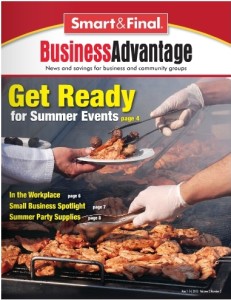Planning a Cool Summer Bash [Business Advantage]
By Diane Rumbaugh
With warm weather just around the corner, many corporate and nonprofit groups are busy planning summer events—much of which takes place outdoors. An outdoor event offers its own set of opportunities and challenges.
PLANNING
When planning any event, organizers must first decide what they hope to accomplish—is it to raise money for a worthy cause, show employees how much they are appreciated, impress potential investors, celebrate an important milestone or anniversary?
Second, is setting a realistic budget. Make sure all costs are factored in so there are no surprises. Will you require RSVPs? If not, you may end up paying for food you do not use. Understanding the fine print of contracts is important. “Many people don’t read contracts thoroughly. There can be lots of hidden fees including corkage fees, server fees, chef fees, power charges and security fees,” says Cassie Brown, chief experience officer at TCG Events, a national event planning company. “Understand everything before signing.”
If using an event planner, Brown says to make sure the planner has the right experience. “Event planners come with all levels of experience. Most have great ideas, but can they turn them into reality? Ask a lot of questions about logistics and see how they respond before selecting the planner,” cautions Brown. Businesses and organizations should expect a line-by-line production schedule from the planner of what will happen Before, during and after the event. When the big day comes, the planner should be on site to manage vendors, address any problems and oversee the cleanup.
If you are planning an outdoor event yourself, food transportation, preparation and storage must be addressed. How will the food be transported? How will it be kept hot or cold? “Sanitation is big especially when volunteers are preparing, handling and cooking the food. They may not know the proper cleaning procedures to prevent cross contamination,” says Brown. “Another issue is not having enough ice. It is easy to underestimate the amount of ice needed to keep food at the right storage temperature, especially outdoors.”
Some nonprofits have been holding the same kind of event for so long, planning is hectic but also runs like clockwork. The Western Region Little League Tournament holds a picnic for between 400 and 450 participating players, parents, coaches and managers every August prior to tournament play. Planning Begins in June with 50 volunteers helping out.
The picnic is held at the Western Region’s sports complex under a large open sided tent that provides shade from the summer heat. Jim Gerstenslager, the Western Region director, says there was some trial and error when they first began hosting the picnic nine years ago.
“At first, we weren’t estimating the food right,” says Gerstenslager. “Now, we know about how many players and how many parents, coaches and managers are going to be here. The San Bernardino Sheriff’s Department prepares and serves the food so they are in charge of food handling and food safety. We always keep a little extra food on hand in case we start to run out. Ambassadors from the San Bernardino Chamber of Commerce make sure the food lines are moving and no one is taking too much food.”
WHAT TO SERVE
“People want to eat healthier,” says Lisa Peters, president of Randy Peters Catering & Event Planning in Citrus Heights, California. “We serve lots of vegetarian dishes, veggie patties and salads. Quinoa is very popular. While barbequed meat is still the main course in summer, it doesn’t have to dominate your menu. You can add more vegetables and fresh fruits. We steer away from mayonnaise-based food items to avoid any health issues.”
Food can be an interactive experience, especially in summer. “We catered a party last year where we cooked paella over fire pits. We served barbequed meat, Brazilian churrascaria-style, on skewers,” says TCG Events’ Brown. “It created an easy ‘wow’ factor. At another event, we had the chef make desserts at each of the tables. It got people talking to each other.Serving family style food instead of plated food is another way to encourage interaction.”
For events serving alcohol, Brown sees small batch liquors growing in demand and signature drinks fading.“People are more educated about liquor than they were before,” she says. “They want to try something new— small batch bourbons, scotches and vintage cocktails such as gin martinis.”
Summer desserts are on the lighter side. Peters’ company caters between 25 and 30 events per day during the summer. She often serves strawberry shortcake, fruit tarts and pies, with popsicles and cotton candy for kids.“Ice cream is also popular although it’s hard to maintain for an outdoor event,”says Peters.
Since all the food is donated, Gerstenslager takes a different approach for his Little League picnic menu.“We keep everything the same,” he says. “It’s hamburgers and hot dogs,corn on the cob and baked beans. Smart & Final donates macaroni salad, nacho chips, cheese, salsa, hamburger and hot dog buns and powdered lemonade and tea.”
CREATING A MEMORABLE EVENT
The food may be delicious, but that isn’tenough. If there is a program to go alongwith the food, make sure it does not bog down the festivities. This is especially true for a nonprofit event.
“Hungry people are distracted people; don’t wait to feed your audience,” explainsBrown. “Too many events feature hours of upfront speeches and entertainment prior to providing dinner or even hors d’oeuvres.By pushing up the food portion of theevent, you’re more likely to have a happy,satisfied audience that’s far more receptiveto your message. Make the ‘ask’ early, makeit once, and make it count. Usually, themain point of the event—the fundraising
part—happens at the end. But by thatTime, you’ve lost valuable audience attention whether due to event fatigue or to some of your prime donors sneaking out early.”
Gerstenslager’s rule is to keep his opening remarks short.“I welcome every team and get everyone clapping and cheering.That’s it, otherwise they lose interest,” he says. One way nonprofit events can quickly lose audience engagement is giving sponsors the microphone warns Brown.
By the time a few sponsors give their five or 10-minute spiel, 15 or 20 minutes will have passed. “A two-minute, professionally designed, powerful video that features the sponsors has a far bigger impact,” suggests Brown. “Everyone wins: the sponsors, your organization and most importantly the audience.”
MORE THAN GREAT FOOD
Proper event lighting, sound and temperature are also keys to success. “The lighting can be too bright or not bright enough, theMusic can be too loud,” notes Peters. “We’re always watching the weather when we cater an outside event. It’s not just heat in the summer. Wind can be a problem. We try to find the happy medium for the senses.”
Service can also make or break an event—whether the service comes from volunteers or a paid staff. “Prime rib is prime rib,” says Peters. “Service has to meet all your guests’ expectations.Smiles are everything. Guest must know that you are there to take care of them.”
Brown believes that all events have a finite life cycle. You want to continue to surprise people,” she says. “If you’ve always had a seated diner, try a family-style set-up or introduce food stations.Switch the venue. Always change things up.”
Once an event is over, there is still work to be done. “Hold a long debrief after every event,” suggests Brown. “Constantly review what you are doing and make tweaks to make your next event even better.”
Read the original article in Business Advantage.


